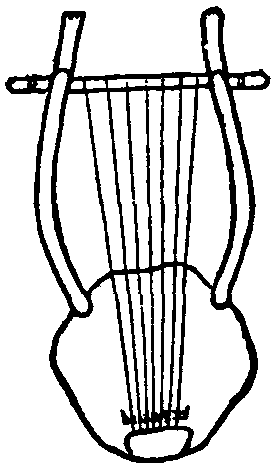Chelys on:
[Wikipedia]
[Google]
[Amazon]
 The chelys or chelus ( el, χέλυς, la, testudo, both meaning "turtle" or "tortoise"), was a
The chelys or chelus ( el, χέλυς, la, testudo, both meaning "turtle" or "tortoise"), was a  The word has been applied arbitrarily since classic times to various stringed instruments, some bowed and some plucked, probably owing to the back being much vaulted.
The word has been applied arbitrarily since classic times to various stringed instruments, some bowed and some plucked, probably owing to the back being much vaulted.
Chelys-Lyra, Greece, 400 BCE
{{Greek musical instruments Ancient Greek musical instruments Lyres String instruments
 The chelys or chelus ( el, χέλυς, la, testudo, both meaning "turtle" or "tortoise"), was a
The chelys or chelus ( el, χέλυς, la, testudo, both meaning "turtle" or "tortoise"), was a stringed musical instrument
String instruments, stringed instruments, or chordophones are musical instruments that produce sound from vibrating strings when a performer plays or sounds the strings in some manner.
Musicians play some string instruments by plucking the st ...
, the common lyre
The lyre () is a stringed musical instrument that is classified by Hornbostel–Sachs as a member of the lute-family of instruments. In organology, a lyre is considered a yoke lute, since it is a lute in which the strings are attached to a yoke ...
of the ancient Greeks, which had a convex back of tortoiseshell
Tortoiseshell or tortoise shell is a material produced from the shells of the larger species of tortoise and turtle, mainly the hawksbill sea turtle, which is a critically endangered species according to the IUCN Red List largely because of its ...
or of wood shaped like the shell. The word ''chelys'' was used in allusion to the oldest lyre of the Greeks, which was said to have been invented by Hermes
Hermes (; grc-gre, Ἑρμῆς) is an Olympian deity in ancient Greek religion and mythology. Hermes is considered the herald of the gods. He is also considered the protector of human heralds, travellers, thieves, merchants, and orato ...
. According to the ''Homeric Hymn
The ''Homeric Hymns'' () are a collection of thirty-three anonymous ancient Greek hymns celebrating individual gods. The hymns are "Homeric" in the sense that they employ the same epic meter—dactylic hexameter—as the ''Iliad'' and ''Odyssey'', ...
to Hermes'', he came across a tortoise near the threshold of his mother's home and decided to hollow out the shell to make the soundbox of an instrument with seven strings.
 The word has been applied arbitrarily since classic times to various stringed instruments, some bowed and some plucked, probably owing to the back being much vaulted.
The word has been applied arbitrarily since classic times to various stringed instruments, some bowed and some plucked, probably owing to the back being much vaulted. Athanasius Kircher
Athanasius Kircher (2 May 1602 – 27 November 1680) was a German Jesuit scholar and polymath
A polymath ( el, πολυμαθής, , "having learned much"; la, homo universalis, "universal human") is an individual whose knowledge spans ...
(''Musurgia universalis'', 486) applied the name of chelys to a kind of viol
The viol (), viola da gamba (), or informally gamba, is any one of a family of bowed, fretted, and stringed instruments with hollow wooden bodies and pegboxes where the tension on the strings can be increased or decreased to adjust the pitc ...
with eight strings. Numerous representations of the chelys lyre or testudo occur on Greek vases, in which the actual tortoiseshell is depicted. A good illustration is given in '' Le Antichità di Ercolano'' (vol. i. p1. 43). Propertius
Sextus Propertius was a Latin elegiac poet of the Augustan age. He was born around 50–45 BC in Assisium and died shortly after 15 BC.
Propertius' surviving work comprises four books of ''Elegies'' ('). He was a friend of the poets Gallus a ...
(iv. 6) calls the instrument the ''lyra testudinea''. Joseph Justus Scaliger
Joseph Justus Scaliger (; 5 August 1540 – 21 January 1609) was a French Calvinist religious leader and scholar, known for expanding the notion of classical history from Greek and Ancient Roman history to include Persian, Babylonian, Jewish an ...
was probably the first writer to draw attention to the difference between the chelys and the kithara.
The acoustics of an authentically reconstructed ancient Greek tortoise-shell lyre, known as chelys, was investigated in 2011.E. Bakarezos, V. Vathis, S. Brezas, Y. Orphanos and N.A. Papadogiannis, "Acoustics of the Chelys - An
ancient Greek tortoise-shell lyre" Applied Acoustics 73, 478 (2012) Modern experimental methods were employed, such as electronic speckle pattern laser interferometry and impulse response, to extract the vibrational behavior of the instrument and its main parts. Additionally, the emitted sound from the instrument was recorded, under controlled conditions, and spectrally analyzed. Major findings include the concentration of the emitted sound between 400 Hz and 800 Hz, with an amplitude modified in a manner consistent with the experimentally measured vibrational characteristics of the instrument’s sound box and bridge. The experimental results validate the historical evidence that chelys was used in Greek antiquity as an accompaniment instrument to the human voice.
Notes
References
*External links
Chelys-Lyra, Greece, 400 BCE
{{Greek musical instruments Ancient Greek musical instruments Lyres String instruments